The Bobo Tuba Collection
Conn Contrabass Trombone in BBb
This Instrument was built before 1909, we know this because the Conn Company has no record of this instrument because of a saver in 1909 and all records were destroyed and all the records prior to the fire were lost. We know that Conn built two contrabass trombones, one is in the Conn museum and the other is in the Bobo collection. The first, the one in the Conn Museum is a single bore instrument meaning the same bore goes through both slides. It is very stuffy and nearly impossible to play. The Bobo collection horn, however, is a duel bore instrument with the first slide being about the size of a modern bass trombone and the second rap of the slide being a 1/16" larger, it is free blowing and makes a beautiful sound.
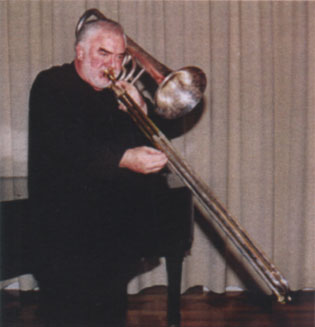 This instrument first came to the surface with William Bell then tubist with the New York in 1954. In 1958 Roger Bobo went to New York from Rochester, Where he was playing in the Rochester Philharmonic while being a student an the Eastman School of Music, to take a lesson from William Bell. Having a fascination for contrabass trombone, although having never seen one, he asked Mr. Bell if he knew where he might be able to find such an instrument. William Bell went to his Locker in the dressing room of Carnegie Hall and got the contra. Roger played it for a few minutes after Mr. Bell offered to sell it to Roger for $450.oo. Even in 1958 that was not only a good deal, that was a gift!
This instrument first came to the surface with William Bell then tubist with the New York in 1954. In 1958 Roger Bobo went to New York from Rochester, Where he was playing in the Rochester Philharmonic while being a student an the Eastman School of Music, to take a lesson from William Bell. Having a fascination for contrabass trombone, although having never seen one, he asked Mr. Bell if he knew where he might be able to find such an instrument. William Bell went to his Locker in the dressing room of Carnegie Hall and got the contra. Roger played it for a few minutes after Mr. Bell offered to sell it to Roger for $450.oo. Even in 1958 that was not only a good deal, that was a gift!
Several months later, back in Rochester, the Philadelphia came through while on tour. The 20 year old Roger Bobo met Philadelphia tubist Abe Torchinsky and quickly found the opportunity to show Mr. Torchinsky his new contrabass trombone. Immediately Mr. Torchinsky became very agitated and a very confused Roger Bobo finally asked what was the matter. It seems that just 4 years before Mr. Torchinsky had given the very same contrabass trombone to William Bell as a Christmas present!
After some time Mr. Torchinsky told Roger that it wasn't really his instrument in the first place but that he had found it in a old storage room in the Philadelphia Symphony's hall!
In 1960 Roger Bobo had an F attachment added to the instrument which the obvious inertia problem of moving a very heavy double slide from a 6th or 7th position to first position much easier to negotiate.
Strucel Contrabass Trumpet in F
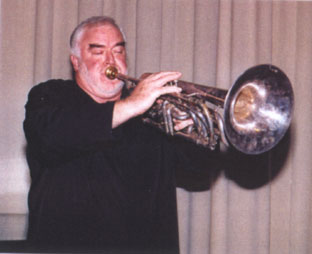 In 1967 Roger Bobo along with Tom Stevens, Mario Guarnieri, and Miles Anderson, all young new members of the Los Angeles Philharmonic, formed the Los Angeles Brass Quintet. Among the works in their repertoire were the four part Canzonas by Gabrieli and the five part dances of Pezel. As always, Roger Bobo was looking for the correct sounding instrument, in this case particularly music of this period. Starting with CC tuba he changed to F, unsatisfied he tried contrabass trombone, nothing seemed right. In the mean time Miles Anderson had dropped trombone for this music and exchanged if for the more fluent and "trumpet homogeneous" bass trumpet. Very quickly Bobo saw what needed to be done, clearly the answer was a contrabass trumpet.
In 1967 Roger Bobo along with Tom Stevens, Mario Guarnieri, and Miles Anderson, all young new members of the Los Angeles Philharmonic, formed the Los Angeles Brass Quintet. Among the works in their repertoire were the four part Canzonas by Gabrieli and the five part dances of Pezel. As always, Roger Bobo was looking for the correct sounding instrument, in this case particularly music of this period. Starting with CC tuba he changed to F, unsatisfied he tried contrabass trombone, nothing seemed right. In the mean time Miles Anderson had dropped trombone for this music and exchanged if for the more fluent and "trumpet homogeneous" bass trumpet. Very quickly Bobo saw what needed to be done, clearly the answer was a contrabass trumpet.
Bobo started consultations with George Strucel and within a few months the instrument was finished.
The bell was a Bach bass trombone bell, the cylindrical tubing and the rotary valve worked with the left thumb, was also provided by Bach but the rest of the instrument was made from parts of discarded instruments found at the Lockie Music Exchange, for example; the 3 valves were found on a very old Eb alto horn. The mouthpiece was made the next year by Reynold Schilke. This instrument was another of those gift instruments like the contrabass trombone, other than the parts, George Strucel charged Roger $125 to design and build this contrabass trumpet.
This instrument can be heard in the Los Angeles Brass Quintet recordings made with Crystal Records.
Miraphone Tuba in G
In the mid 50's, when Miraphone was a new instrument on the market and was imported by Lockie Music Exchange in Los Angeles, there were rumours that Miraphone had a G tuba and it was in fact in Los Angeles at the Lockie Music Exchange. In short, no one was interested.
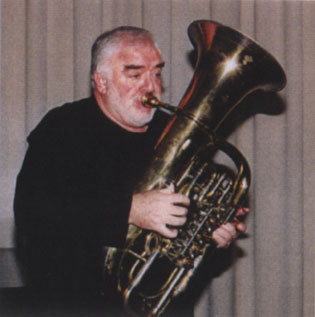 When Roger Bobo returned to Los Angeles in 1964 after the 2 years in Amsterdam with the Concertgebouw Orchestra he began his 25 year period with the Los Angeles Philharmonic Orchestra. In those first years Roger was always seeking instruments that would sound optimum for any specific work. He took note that most symphony trumpet players of the time had a collection of instruments in different keys and sizes in hopes that one would provide the perfect timbre and technical fluency for any given work. This approach seemed to work very well for trumpet players, why not tubists?
When Roger Bobo returned to Los Angeles in 1964 after the 2 years in Amsterdam with the Concertgebouw Orchestra he began his 25 year period with the Los Angeles Philharmonic Orchestra. In those first years Roger was always seeking instruments that would sound optimum for any specific work. He took note that most symphony trumpet players of the time had a collection of instruments in different keys and sizes in hopes that one would provide the perfect timbre and technical fluency for any given work. This approach seemed to work very well for trumpet players, why not tubists?
One problem that all orchestral tubist must address is what is the correct instrument to use in the works of Berlioz. The problem is NOT the high register of these (originally ophiclide) parts but to get a tone colour that is appropriate for an ophiclide and in the sonic texture of a modern symphony orchestra. The G tuba can be played with the energy appropriate for these passages, frequently unisons with the trombones, but still fit inside the trombone sound, while the same passages played on a normal symphonic F tuba tend to dominate the trombone section.
In seeking the most appropriate instrument possible for the works of Berlioz., Roger remembered the rumours of the G tuba he had heard in the 50's. He asked the Lockie Music Exchange about this instrument and was given it as a gift from Lockie's the next day.
It's difficult to say WHY Miraphone had built and Lockie's had a G tuba, Miraphone actually has no record of building such a tuba. The only plausible explanation offered is that it was originally intended to be an F tuba in a German military band. Instruments for German military bands at that time were tuned one half tone sharp for brilliance, that would have already put the instrument in F#. It's been guessed that because of its small size and/or that it may have been a sharp F# it was changed to a G and subsequently rejected and stored away.
Alexander Tenor Tuba 151 in Bb
In the late 60's Tommy Johnson, long time friend and tubist colleague of Roger Bobo, took ownership of an Alexander Tenor tuba and learned quickly the advantages of such an instrument. Particularly, this instrument seemed to be the perfect instrument for Bydlo, the famous tuba solo in the Ravel orchestration of Pictures at an Exhibition by Mussorgsky
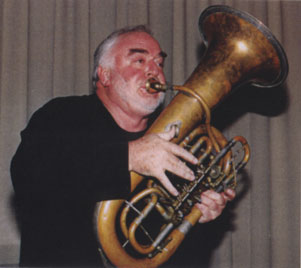 After seeing, hearing and playing this instrument, Roger stopped at the Alexander factory in Frankfurt am Mainz while on vacation, and ordered his own Alexander 151 tenor. Both the Johnson and Bobo tenors are very similar except Bobo added a 5th valve to his after his return to Los Angeles. The parts for the 5th valve (valve and tubing) were supplied by Alexander and the addition of the valve to the tuba was done by George Strucel, the horn maker and brass repair
After seeing, hearing and playing this instrument, Roger stopped at the Alexander factory in Frankfurt am Mainz while on vacation, and ordered his own Alexander 151 tenor. Both the Johnson and Bobo tenors are very similar except Bobo added a 5th valve to his after his return to Los Angeles. The parts for the 5th valve (valve and tubing) were supplied by Alexander and the addition of the valve to the tuba was done by George Strucel, the horn maker and brass repair
Other than for Bydlo, this instrument was used frequently, both in the Los Angeles Philharmonic and the Television and motion picture studios in Hollywood. It can also be heard on Crystal Records #126 PRUNES in Bobo's arrangement of the Bach "Air for the G string".
It should also be mentioned that Strucel made Bobo a mouthpiece for this tenor tuba which was very successful. The rim was a normal rim for a tuba mouthpiece but the cup was quite shallow and far more appropriate for a tenor instrument. Copies of this mouthpiece are available form Yamaha; the Bobo TT modal.
There is a very clear parallel with the way a tubist uses a tenor tuba with the way a trumpet player uses a piccolo trumpet.
Miraphone / Besson / Minick Tuba in D
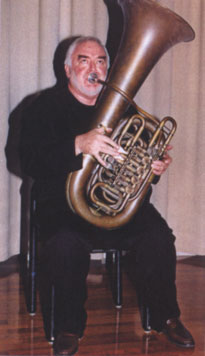 The Miraphone CC 184 5U was a wonderful instrument, it could move, it could sing, it could project but it had become evident that it simply didn't have the sonic mass to put a bottom on a symphony orchestra. Roger Bobo played this instrument whenever possible but those possibilities were becoming less and less frequent. In 1972 Bobo had Larry Minick exchanged the original Miraphone 184 bell with a Besson Eb Imperial bell. It was an absolutely perfect fit. Although this opened the sound up considerably it still was not the ideal symphony tuba. This instrument with the Besson bell was used for the second recorded Bobo made of the William Kraft Encounters II for solo tuba. After that recording the instrument sat for several years unused.
The Miraphone CC 184 5U was a wonderful instrument, it could move, it could sing, it could project but it had become evident that it simply didn't have the sonic mass to put a bottom on a symphony orchestra. Roger Bobo played this instrument whenever possible but those possibilities were becoming less and less frequent. In 1972 Bobo had Larry Minick exchanged the original Miraphone 184 bell with a Besson Eb Imperial bell. It was an absolutely perfect fit. Although this opened the sound up considerably it still was not the ideal symphony tuba. This instrument with the Besson bell was used for the second recorded Bobo made of the William Kraft Encounters II for solo tuba. After that recording the instrument sat for several years unused.
In 1978 Roger Bobo thought instead of letting this wonderful sit unused it would be better to use it and a D tuba, which Bobo had been thinking about for sometime, would be the logical thing. The work began and the D tuba was ready in a few months. It was a better D than it was a CC, and it was a great CC. As a CC tuba the 184 was quite a small instrument but as a D the proportions were much better.
This instrument was never used frequently but it sounded extraordinarily correct for Brahms 2nd and Dvorak 8th.
Minick Cimbasso in F
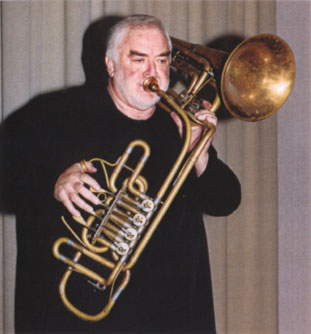 This cimbasso was built for Roger Bobo by Larry Minick in 1984. Originally it was to have been in Eb, but early in the project, because of the way the instrument felt at the first test of actually blowing it and because of closer study of the Italian opera repertoire, both Bobo and Minick agreed a cimbasso in F would be more appropriate.
This cimbasso was built for Roger Bobo by Larry Minick in 1984. Originally it was to have been in Eb, but early in the project, because of the way the instrument felt at the first test of actually blowing it and because of closer study of the Italian opera repertoire, both Bobo and Minick agreed a cimbasso in F would be more appropriate.
The cimbasso was used frequently in the Los Angeles Philharmonic and the Hollywood studios in the late 80's, but it was in the 1990 and 1991 that gained attention when Roger Bobo used it in productions and subsequent recordings of Il Trovatore and Tosca with the orchestra of the Maggio Musicale in Florence conducted by Zubin Mehta. Maestro Mehta was pleased enough with this Cimbasso that he personally phoned Larry Minick in Los Angeles and requested that Larry make another cimbasso for the Maggio Musicale Orchestra. Having just recently retired the instrument making business, Mr. Minick declined the request.
Yamaha 622 F Tuba:
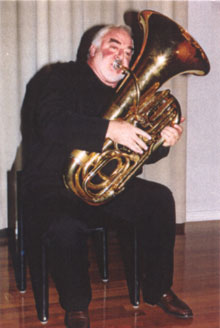 This Gold plated tuba was made for Bobo to his specifications in 1990 by Thomas Lubitz, instrument maker and designer for Yamaha at their atelier in Frankfurt. After leaving the Los Angeles Philharmonic on a sabbatical in 1989 and deciding after 6 months not to return to the Los Angeles position, Bobo decided to change to Yamaha after having tried their instruments at several exhibitions.
This Gold plated tuba was made for Bobo to his specifications in 1990 by Thomas Lubitz, instrument maker and designer for Yamaha at their atelier in Frankfurt. After leaving the Los Angeles Philharmonic on a sabbatical in 1989 and deciding after 6 months not to return to the Los Angeles position, Bobo decided to change to Yamaha after having tried their instruments at several exhibitions.
This particular instrument is almost the same proportions as the 621 series in F but is far more ergonomically comfortable. In 2000 Bobo was given a larger bell for tuba and the two bells are interchangeable depending on which sound is preferred.
This tuba was used on all the last recordings Bobo made from 1990 to 2000. This Instrument (the 622 BL) is now available from Yamaha on special order.
Strucel / Minick Bass Horn in CC
 The realization of this bass horn was simply a process of imagination. Having a contrabass trombone and a contrabass trumpet Roger Bobo felt it only to be logical that he should also have a bass horn. He proposed the idea to Howard Lockie of Lockie Music Exchange in 1970 and the parts for the instrument; bell, cylindrical tubing, a 5 rotary valve section and a few sheets of nickel silver brass, soon appeared in Los Angeles and were immediately put into the hands of George Strucel. Strucel soon had the plans down on paper and he was ready to begin building. The project remained on hold for the next 6 years, George Strucel moved his career to Sweden and Bobo moved almost exclusively into modern music, temporarily forgetting the bass horn. Finally Bobo took the parts and plans for the instrument which Strucel had left with him to Larry Minick.
The realization of this bass horn was simply a process of imagination. Having a contrabass trombone and a contrabass trumpet Roger Bobo felt it only to be logical that he should also have a bass horn. He proposed the idea to Howard Lockie of Lockie Music Exchange in 1970 and the parts for the instrument; bell, cylindrical tubing, a 5 rotary valve section and a few sheets of nickel silver brass, soon appeared in Los Angeles and were immediately put into the hands of George Strucel. Strucel soon had the plans down on paper and he was ready to begin building. The project remained on hold for the next 6 years, George Strucel moved his career to Sweden and Bobo moved almost exclusively into modern music, temporarily forgetting the bass horn. Finally Bobo took the parts and plans for the instrument which Strucel had left with him to Larry Minick.
Soon the instrument was finished, on first try it was an almost perfectly in tune and very even in timbre through all registers. After a few weeks of work it became abundantly clear that this was indeed an extraordinary instrument; only one problem; where could it be used?
It is a single CC horn with 5 valves, 1,2,3, and 4 in the left hand and 5 in the thumb of the left hand. The 5th valve is tuned like all the rest of Bobo's instruments, almost two steps or stated another way the 5th valve equals a sharp 2/3 combination.
Soon after Bobo realized what he had the word was put out several film scores were written for Bobo's bass horn but most notably Bobo friend and composer Roger Kellaway wrote two works; "Dance of the Ocean Breeze" and "Sonoro" as duets for horn and bass horn. These were recorded in 1981 with Norwegian hornist Frøydis Ree Wekre with Crystal Records. Sometimes in his last years in Los Angeles Bobo would use the bass horn on certain works where the tuba part was, in fact, used as a low horn part. This, for the most part, proved to be very successful
 This instrument first came to the surface with William Bell then tubist with the New York in 1954. In 1958 Roger Bobo went to New York from Rochester, Where he was playing in the Rochester Philharmonic while being a student an the Eastman School of Music, to take a lesson from William Bell. Having a fascination for contrabass trombone, although having never seen one, he asked Mr. Bell if he knew where he might be able to find such an instrument. William Bell went to his Locker in the dressing room of Carnegie Hall and got the contra. Roger played it for a few minutes after Mr. Bell offered to sell it to Roger for $450.oo. Even in 1958 that was not only a good deal, that was a gift!
This instrument first came to the surface with William Bell then tubist with the New York in 1954. In 1958 Roger Bobo went to New York from Rochester, Where he was playing in the Rochester Philharmonic while being a student an the Eastman School of Music, to take a lesson from William Bell. Having a fascination for contrabass trombone, although having never seen one, he asked Mr. Bell if he knew where he might be able to find such an instrument. William Bell went to his Locker in the dressing room of Carnegie Hall and got the contra. Roger played it for a few minutes after Mr. Bell offered to sell it to Roger for $450.oo. Even in 1958 that was not only a good deal, that was a gift!





